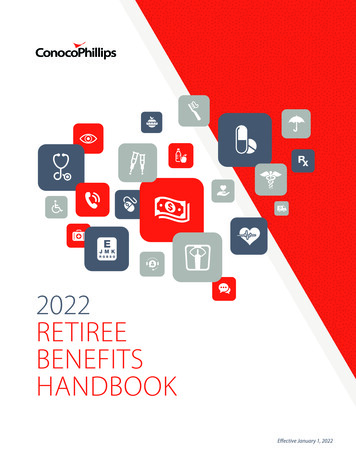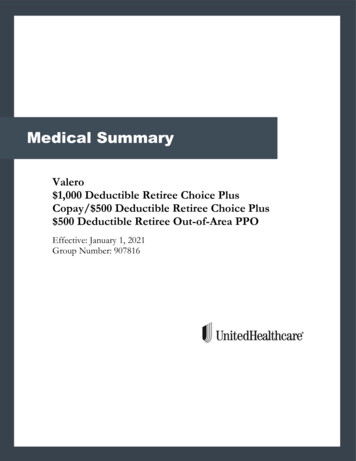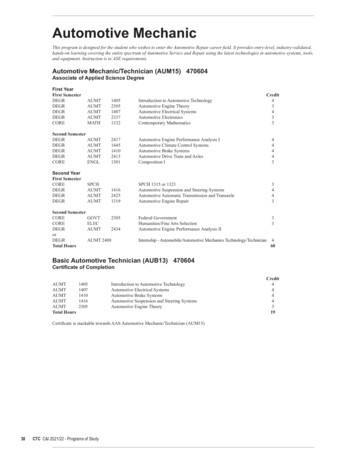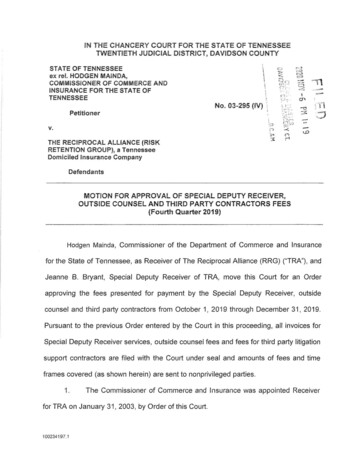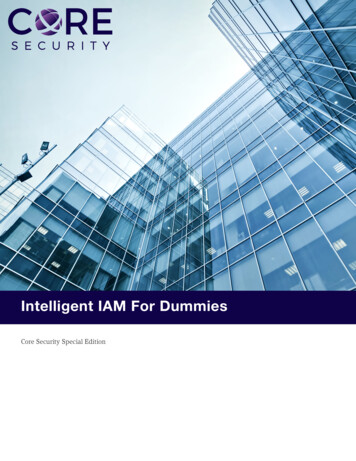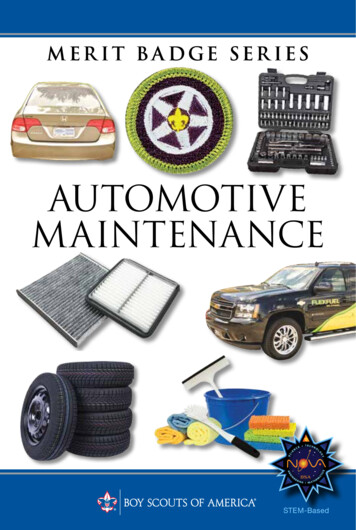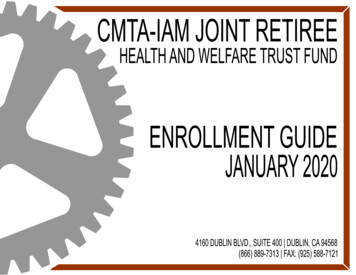
Transcription
/
CMTA-IAM JOINT RETIREEHEALTH AND WELFARE TRUST FUNDENROLLMENT GUIDEJANUARY 20141640 South Loop Road, Alameda, CA 94502Post Office Box 24160, Oakland, CA 94623-1160(800) 662-0738
CMT A-I AM J OINT RETI REE HE ALT H & WE LFARE T RUSTAbout Your Plan BenefitsDecember 2019A Message from Our TrusteesRising health care costs are a major concern for all of us, and those on a fixed income are hit the hardest. Health careinflation has left our retirees paying more for doctor visits, hospital stays, and prescription drugs. In addition, retireeseligible for a subsidy provided through employer contributions have seen that subsidy decrease—leaving our retireesresponsible for a larger portion of the self-payment required for coverage.Yet, while we are faced with very real challenges on the health care front, the CMTA-IAM Joint Retiree Health and WelfareTrust remains committed to providing retired members with access to affordable, quality health care coverage. The planscan protect against the high costs of treating major illness or injury, and cover many day-to-day health care needs. Thisgives you greater flexibility to match a medical plan to your personal health situation at a price you can afford.We encourage you to review this Benefits Guide. It describes your health plan options, eligibility for these plans, and thesteps you should take to enroll in a plan. If you have questions after reading this Guide, please contact the Trust Fund Officeat (866) 889-7313.This Retiree Plan has been determined to be a “Retiree only Plan” meaning that is not subject to many of the grouphealth requirements under HIPAA and the PPACA (Health Reform).This Benefit Guide provides only highlights of certain features of the CMTA-IAM Joint Retiree Health & Welfare Trust Planbenefits. Full details are contained in the documents that establish the Plan provisions. If there is a discrepancy between thewording here and the documents that establish the Plan, the document language will govern.The Trustees reserve the right to amend, modify, or discontinue all or part of the Plan at any time. No Retiree,Spouse/Domestic Partner or any other person shall have any vested right to any benefits provided by the Plan.3
What’s New for 2020Trust Fund SubsidyMonthly retiree self-payments are required for coverage under the plan. Currently, employers contribute a portion of thecost of coverage for retirees which subsidizes some of your out of pocket expenses for those who are entitled to a subsidy.The applicable subsidy amount is loaded on a debit card that you can use for copayments. The flat monthly subsidyamounts are 1.60 for single, 2.80 for two-party and 4.00 for family effective January 1, 2020. Note that the subsidyamount is loaded twice a year (January and July).Your Health Plan OptionsInformation regarding the Trust-sponsored health plan options is organized in two sections: for Non-Medicare Retirees andfor Medicare Retirees.Health Plan Options for Non-Medicare RetireesNon-Medicare Retirees are our retired members under age 65, who are not yet eligible for Medicare. The following plansare available, based on where you live.Non-Medicare Retiree Health Plan OptionsPlan OptionPlan TypeNew enrollment open to Kaiser HMO PlanHMOCalifornia residents onlyKaiser Deductible HMO PlanHMOCalifornia residents onlyUnitedHealthcare HMO PlanHMOCalifornia residents onlyEffective January 1, 2020, new enrollees will not be accepted into the Kaiser HMO plan in Oregon and Hawaii.There will also be no re-entry to these plans for current participants. Please see list above for the list of availablehealth plan options.4
Before choosing a plan, it is important to understand how each plan works, the benefits provided, and the costs you mayincur under each plan (self-payments and out-of-pocket expenses).Following is an explanation of the plan types noted in the table above. Refer to these definitions, along with the BenefitPlan Summaries included with this Guide, when deciding which plan is right for you.Health Maintenance Organizations (HMOs)The Trust Fund’s HMO plans (provided through Kaiser and United Healthcare) require you to receive care and servicesfrom specific medical providers (physicians, hospitals, pharmacies, etc.) who contract with the HMO. This means you haveaccess to network providers only, except when you need emergency care. You must select a Primary Care Physician (PCP)or medical group that coordinates your total health care, including arranging referrals to specialists and other participatingproviders for laboratory tests, X-rays, hospitalization, and medications.Except for the Kaiser Deductible HMO plan, there is no deductible to meet before benefits are payable. In most cases,claim forms are not required. Some copayments apply, and you are responsible for those copayments at the point of care. Ifyou use providers who are not in the network, you may have to pay the entire cost of the service (with the exception ofemergency care).Refer to the Benefit Plan Summaries included in this Guide, for highlights of benefits provided under each plan.5
Health Plan Options for Medicare RetireesMedicare Retirees are our retired members, generally age 65 and over, who are eligible for Medicare. The following plansare available, based on where you live.Medicare Retiree Health Plan OptionsPlan OptionPlan TypeNew enrollment open to Health Net Seniority Plus Plan *Medicare Advantage HMOCalifornia residents onlyKaiser of California Senior Advantage Plan - 10Medicare Advantage HMOCalifornia residents onlyPlan **Kaiser of California Senior Advantage Plan - 20Medicare Advantage HMOCalifornia residents onlyPlan **Kaiser of Washington HMO Plan *Medicare Advantage HMOWashington residents onlyUnitedHealthcare Secure Horizons HMO PlanMedicare Advantage HMOCalifornia residents onlyUnitedHealthcare Senior Supplement Plan (Plan C) Medicare Supplement InsuranceResidents of any stateUnitedHealthcare Prescription Drug Only PlanMedicare Part D Prescription Drug Plan Residents of any stateEffective January 1, 2020, new enrollees will not be accepted into the Kaiser HMO plan in Oregon and Hawaii. Therewill also be no re-entry to these plans for current participants. Please see list above for the list of available health planoptions.*Retiree and any eligible dependents must all be eligible for and enrolled in Medicare Part A and Part B.**Additional hearing aid and dental coverage is available. However, you will have to pay 100% of the premium.As you consider which plan is right for you, it is important to first understand how Medicare and your CMTA-IAM JointRetiree Health and Welfare Trust plan benefits work together to provide your health care benefits.6
How Medicare WorksYou get Medicare Part A automatically if you sign up for Social Security. You need to sign up for Medicare Part B.Medicare coverage typically begins the first day of the month in which you turn 65, if you enroll in Medicare during thethree months before the month you turn age 65.When you become eligible for and enroll in Medicare, coverage is provided as follows: Medicare Part A provides hospital insurance. It helps pay for Medicare-approved hospital stays, care in skilled nursingfacilities, hospice care, home healthcare, and hospital care from qualified Medicare providers. You typically do not pay apremium for Part A coverage if you or your spouse/domestic partner paid for Medicare through payroll taxes while youwere working. Medicare Part B provides medical insurance. It helps pay for Medicare-approved doctor services, outpatient care,certain preventive care services, diagnostic tests, and some other services and supplies that Medicare Part A does notcover. You pay a monthly premium for Part B coverage. Most participants pay a monthly premium of 144.30 in 2020(unless you are considered a high income beneficiary).Medicare Parts A and B are known as the “Original Medicare” plan. To enroll in a medical plan offered through theTrust Fund, you must be enrolled in Medicare Parts A and B. Medicare Part C allows you to receive your Part A and B Medicare benefits through Health Care Prepayment Plans(HCPP), Cost Plans, Medicare Risk plans, Medicare Plus Choice plans or most commonly, Medicare Advantage plans.A Medicare Advantage plan is a health plan (such as an HMO) approved by Medicare and run by a private insurancecompany. The Trust Fund sponsors several Medicare Advantage plans for our retired members. Refer to page 6 for moreinformation regarding Medicare Advantage plans. An individual is entitled to Part C if they are entitled to Part A andenrolled in Part B and live in a Part C service area (certain specific exceptions apply). Medicare Part D helps to cover your prescription drug costs. When you become entitled to or enrolled in Part A orenrolled in Part B, you also have the opportunity to enroll in a Medicare Part D prescription drug plan. Medicareprescription drug plans are run by insurance companies and other private companies approved by Medicare. PleaseNote: If you enroll in one of the Trust Fund’s Medicare Advantage plans or Medicare Supplement plans, yourMedicare Part D prescription drug benefits are covered through that plan. Medicare Advantage and MedicareSupplement plan enrollees should not enroll in a separate Medicare prescription drug plan (please see page 9).7
How the CMTA-IAM Joint Retiree Health and Welfare Trust plans work with MedicareAs noted in the table on page 4, the Trust Fund offers retired members the opportunity to enroll in one of several health planoptions and receive benefits that include and supplement Medicare benefits. You can choose a Trust Fund-sponsored: Medicare Advantage HMO plan covering medical and prescription drugs Medicare supplement plan covering medical and prescription drugs Medicare prescription drug plan (prescription drug coverage only)Medicare Advantage Plans. When you enroll in a Medicare Advantage plan, you agree to allow a private insurancecompany to provide your Medicare Part A and B benefits. Under a Medicare Advantage plan, you authorize Medicare topay your benefits directly to the insurance company. The insurance company decides how benefits are covered under eachplan. Generally, coverage under the Trust Fund’s Medicare Advantage plans is more generous than the coverage providedthrough Original Medicare. The Trust Fund’s Medicare Advantage plans also include Medicare-approved prescription drugcoverage.To join a Trust Fund-sponsored Medicare Advantage plan, you must have Medicare Part A and Part B. You will continue topay your monthly Medicare Part B premium to Medicare, through deductions from your Social Security benefit. In addition,you will pay a monthly premium (your “self-payments”) to the Trust Fund for your Trust Fund-sponsored MedicareAdvantage plan coverage—to cover the extra benefits offered through the plan.You may choose to enroll in one of the following Trust Fund-sponsored Medicare Advantage plans. However, please notethat you may not be eligible to enroll in an HMO plan if you do not live in an HMO service area.8
HMO Plans. When you choose an HMO plan, you must receive all services from HMO-contracted providers. NeitherMedicare nor the HMO (except in emergencies or other pre-approved situations) will provide coverage for servicesreceived from outside providers.The following Medicare Advantage HMO plans are available to you.For California residents: Health Net Seniority Plus PlanKaiser of California Senior Advantage Plan - 10 PlanKaiser of California Senior Advantage Plan - 20 PlanUnitedHealthcare Secure Horizons HMO PlanFor Washington residents: Kaiser of Washington HMO PlanBenefits coverage levels and monthly self-payment premiums vary by plan. Refer to the Benefit Plan Summariesincluded in this Guide, for highlights of benefits provided and the 2020 Self-payment rates. For a thoroughdescription of your benefits, refer to the Evidence of Coverage (EOC) from the insurance company. Please note thatif there is a discrepancy between the Benefit Plan Summaries and the EOC from the insurance company, the EOClanguage will govern.Medicare Supplement Insurance. As an alternative to electing a Medicare Advantage plan, many Medicare beneficiariesopt to purchase Medicare supplement insurance. A Medicare supplement plan is private health insurance designed to paysome of the health care costs not covered by Original Medicare. These plans also include Medicare-approved prescriptiondrug coverage.The Trust Fund offers one Medicare supplement insurance plan—the UnitedHealthcare Senior Supplement Plan. Under thisplan, you may visit any provider, but you incur lower out-of-pocket expenses when you visit a provider who acceptsassignment from Medicare and does not engage in private contracting. For prescription drugs, you may use any pharmacy.9
If you enroll in the United Healthcare Senior Supplement Plan, you must have Medicare Part A and Part B. In addition toyour monthly Medicare Part B premium, you will also pay a premium, through your monthly self-payment to the TrustFund, for your supplement coverage.Refer to the Benefit Plan Summaries, beginning on page 20 of this Guide, for highlights of benefits provided.Prescription Drug Only Plan for Medicare Retirees. While the Trust Fund-sponsored medical plans providecomprehensive, Medicare-creditable prescription drug coverage, the Trust Fund also provides retired members the option ofelecting a stand-alone Medicare prescription drug plan. This plan is designed for individuals who are already covered orintend to seek coverage under a medical plan outside the Trust Fund (such as an individual plan or a plan through aspouse/domestic partner).Under the plan, you must fill your prescriptions at a United MedicareRx participating pharmacy, and mail order service isavailable. The plan also provides participants with phone access (1-888-556-6648) to a pharmacist 24 hours a day, sevendays a week.The following table provides a summary of the Prescription Drug Only Plan. Monthly self-payment premium for this plan isincluded separately with this Guide.Trust Fund-Sponsored Prescription Drug Plan OptionPlan FeatureUnitedHealthcare - 10/ 20/ 35 PlanAnnual DeductibleNo deductibleTier 1 Drugs (generics) 10 copaymentTier 2 Drugs (preferred brand-name) 20 copaymentTier 3 Drugs (non-preferred) 35 copaymentSpecialty Drug Tier * 35 copaymentCoverage GapN/AMail Order (90-day supply)Two times copayment for a 30-day supply at retail pharmacy.* Complex, high-cost drugs that usually have specialized storage, handling and delivery requirements.10
The Trust Fund-sponsored Prescription Drug Only plan is offered as an alternative only to the medical/prescription drugplan options. The Trust Fund will not allow you to enroll in the Trust Fund-sponsored Prescription Drug Only Plan if youchoose to enroll in one of its medical/prescription drug plans. If you enroll in one of the medical/prescription drug plans,you should not enroll in the Prescription Drug Only plan, as Medicare-creditable drug coverage is available under allmedical/prescription drug options.As mentioned before, the Trust Fund’s Medicare Advantage and Medicare supplement insurance plans include prescriptiondrug coverage. Therefore, Medicare Advantage and Medicare supplement plan enrollees should not enroll in a separateMedicare prescription drug plan. If this is done, you may jeopardize your medical coverage or cause yourself unnecessaryadditional costs: Medicare Advantage enrollees (HMO): Retired members who enroll in one of the Trust Fund’s HMO MedicareAdvantage plans and who enroll in a separate Medicare prescription drug plan will be automatically dis-enrolled byMedicare from their medical plan coverage, thus losing their Trust Fund-sponsored medical benefits. If you mistakenlydo this, we encourage you to dis-enroll from your Medicare drug plan and file an appeal with your Medicare Advantageplan to be re-enrolled. UnitedHealthcare Senior Supplement Plan enrollees: UnitedHealthcare Senior Supplement Plan members who enrollin a separate Medicare prescription drug plan will no longer have access to the prescription drug benefits through theUnitedHealthcare Senior Supplement Plan—these benefits will only be provided through the separate Medicareprescription drug plan. Your self-payment to the Trust Fund will not be reduced even though the prescription drugbenefits are no longer available. This will result in unnecessary additional cost to you.Enrolling in a PlanNon-Medicare RetireesNon-Medicare Retirees may enroll in a Trust Fund-sponsored plan or make changes totheir plan election as outlined in this section.Contact the Trust Fund Officeat (866) 889-7313 to request anenrollment form andinstructions for completingyour enrollment.If you wish to change your plan election, contact the Trust Fund Office. Any change you request during this enrollmentperiod is effective the month following receipt of complete enrollment forms.11
Please note: The plan your spouse/domestic partner is enrolled in will depend on the plan you select:If you enroll in Kaiser HMO PlansUnitedHealthcare HMO PlanIf you enroll in Kaiser HMO PlansUnitedHealthcare HMO PlanAnd you have a Non-Medicare-eligiblespouse/domestic partner, they will be enrolled in Kaiser HMO PlansUnitedHealthcare HMO PlanAnd you have a Medicare-eligible spouse/domesticpartner, they will be enrolled in Kaiser Senior Advantage PlansUnitedHealthcare Secure Horizons HMO PlanInitial Enrollment Period — For participants as they become eligible for NonMedicare retiree benefits. Once eligible, Non-Medicare Retirees may enroll in amedical plan at any time. Following initial enrollment, generally you will not be allowedto change your benefit elections or add/delete dependents until you remain in the planselected for a minimum of 12 months. However, you may be eligible to change your planelection before 12 months have passed under the following circumstances:Enrollment and Plan changerequests are effective the firstday of the month followingthe date the enrollment formis received by the Trust FundOffice. You move from your medical plan service area You lose or gain medical plan coverage due to a change in your or your spouse/domestic partner’s employment If, under certain circumstances, a change is approved by the Board of TrusteesEnrollment and plan change requests are effective the first day of the month following the date the Trust Fund Officereceives the properly completed enrollment material. You may initiate your enrollment/change request by calling the TrustFund Office.12
Medicare RetireesYou may enroll in a Trust Fund-sponsored plan or make changes to your plan election asoutlined in this section.If you wish to change your plan election, contact the Trust Fund Office. Your newelection (if you choose to make a change) is effective the first day of the month followingthe date the Trust Fund Office receives the properly completed enrollment material andsubject to approval by the medical plan carrier.Contact the Trust FundOffice at (866) 889-7313 torequest an enrollment formand instructions forcompleting your enrollment.Please note: The plan your spouse/domestic partner is enrolled in will depend on the plan you select:If you enroll in Kaiser of California Senior Advantage PlansHealth Net Seniority Plus PlanUnitedHealthcare Secure Horizons HMO PlanUnitedHealthcare Senior Supplement PlanKaiser of Washington HMO PlanIf you enroll in Kaiser Senior Advantage PlansHealth Net Seniority Plus PlanUnitedHealthcare Secure Horizons HMO PlanUnitedHealthcare Senior Supplement PlanKaiser of Washington HMO PlanAnd you have a Medicare-eligible spouse/domesticpartner, they will be enrolled in Kaiser of California Senior Advantage PlansHealth Net Seniority Plus PlanUnitedHealthcare Secure Horizons HMO PlanUnitedHealthcare Senior Supplement PlanKaiser of Washington HMO PlanAnd you have a Non-Medicare-eligible spouse/domesticpartner, they will be enrolled in Kaiser HMO PlansYou will not be able to enroll your non-Medicare spouse ordomestic partnerUnitedHealthcare HMO PlanUnitedHealthcare PPO PlanYou will not be able to enroll your non-Medicare spouse ordomestic partnerIf you select Health Net or Kaiser of Washington, you and your dependents must be eligible and enrolled in Medicare.You may change your election during the year as noted on page 10 of this Guide, or during the annual Medicare enrollmentperiods described in Medicare’s publication, “Medicare and You 2020.”13
Initial Enrollment Period — For participants as they become eligible for Medicare. The Trust Fund negotiates with itshealth plan carriers to set premium rates, based on the assumption that all Medicare-eligible retirees are entitled to bothMedicare Part A and Part B benefits. Thus, the plans offered through the Trust Fund require that Medicare Retirees areenrolled in Medicare Parts A and B.Medicare coverage typically begins the first day of the month in which you turn 65, ifyou enroll in Medicare during the three months before the month you turn age 65.Generally, there is no monthly premium for Part A coverage. You must pay a monthlypremium for Part B coverage. The 2020 Part B premium for most Medicarebeneficiaries is on average 144.30 per month (there are some exceptions for higherincome individuals).You may be eligible forMedicare earlier than age 65if you become disabled orhave End Stage RenalDisease (ESRD). ContactSocial SecurityAdministration for moreYou can enroll in Medicare Part B when you are first eligible to enroll in Medicare. If you are covered through the TrustFund’s group medical insurance (or another employer’s group insurance plan), you can also enroll in Medicare Part B laterthrough a Part B special enrollment period as follows: Any time you are still covered by a group health plan through your or your spouse/domestic partner’s activeemployment During the eight months following the month your group health plan coverage ends, or when employment ends(whichever is first)Once enrolled in Medicare Part B, you may elect a Trust Fund-sponsored medical plan to cover your health care needs. Youare responsible for any additional premium required—payable to the Trust Fund through your monthly self-payments.To enroll in a Trust Fund-sponsored plan, contact the Trust Fund Office at (866) 889-7313 to request an enrollmentform and instructions for completing your enrollment.IMPORTANT: If you do not enroll in Medicare Part B when you first become eligible or during the other times indicatedabove, you may have to pay a higher Medicare Part B premium because you could have had Medicare Part B and did nottake it. Call the Social Security Administration at 800-772-1213 for more information or to enroll in Medicare.14
When plan election changes are allowed. You may change your plan election outside of the enrollment periods describedpreviously, as follows: If you no longer live in your medical plan’s service area If you lose your group health plan coverage If you are entitled to Medicare and are in a situation that Medicare has decided is an exceptionRefer to Medicare’s publication “Medicare and You 2020” for more information on the annual Medicare enrollmentperiods and special enrollment events. If necessary, contact the Trust Fund Office to discuss your circumstances and initiatea request to change your medical plan election.15
Eligibility for Trust Fund-Sponsored Health Care BenefitsWho is Eligible?RetireeYou are eligible for retiree benefits if: You have retired under a collective bargaining agreement with District Lodge 190 and (a) are receiving benefits from theAutomotive Industries Pension Fund or IAM National Plan, or (2) are at least 55 years of age. You make the proper self-payments for coverage.You may not enroll in this plan both as a retiree and as a dependent. If your coverage in the Plan is cancelled, you will beallowed to re-enroll for coverage under this Plan only once, subject to insurance carrier approval.DependentIf YOU qualify for benefits, the following dependents may be covered: Your spouse or domestic partner (if there is a registered domestic partnership with a government body pursuant to statelaw); Your unmarried children dependent on you for support, including: Biological children; Legally adopted child or a child placed for adoption. Placed for adoption means the assumption and retention by theRetiree of a legal obligation for total or partial support of such child in anticipation of adoption of such child. Thechild’s placement for adoption terminates upon the termination of such legal obligation; Stepchildren Foster children (Please note: Kaiser does not cover foster children, including a foster child who (1) is claimed as an incometax deduction by the retiree, (2) is solely dependent on the retiree for support, and (3) lives in the retiree’s home.);16
A child named as an “alternate recipient” under a Qualified Medical Child Support Order (QMCSO) or a National MedicalSupport Notice. An unmarried grandchild of the retiree under the age of 19 (proof of relationship and age will be required) who iseligible for tax-free health coverage as a “qualifying child” or “qualifying relative” under the applicable requirementsof Internal Revenue Code Section 152(c) or 152(d), respectively OR who is claimed as a dependent on the retiree’sfederal income tax return for each plan year for which coverage is provided. In order to be eligible for tax-freehealth coverage as a “qualifying child,” the grandchild must (i) meet certain age/student limits, (ii) have the sameprincipal place of abode as the participant for over half of the year, and (iii) not provide over half of his/her ownsupport. To be eligible for tax-free health coverage as a “qualifying relative,” the participant must provide over halfof the grandchild’s support, and the grandchild must not be the “qualifying child” of any person.You can cover children up to age 19 (or to age 23, if full-time students at accredited educational institutions and dependenton you for at least half of their support). Disabled Adult Child: an unmarried child who, while eligible as a Dependent, becomes and remains incapable of engaging inself-sustaining employment because of mental or physical disability, and is solely dependent on the Retiree for support. Achild meeting these qualifications shall continue to qualify as a Dependent so long as the parent remains continuously eligibleas a Retiree. Satisfactory evidence of continued disability may be requested by the Fund from time to time.17
Eligibility DateCoverage begins upon proper self-payment on the date you have retired under a collective bargaining agreement withDistrict Lodge 190 and (1) begin receipt of pension payments from a qualified pension plan; or (2) have reached age 55.If you do not wish your coverage to begin on this date, you may apply at a later date. In this case, coverage would begin onthe first day of the month after proper application is made to the Trust Fund Office. Application for Non-Medicare plansmay be made at any time after you are eligible. Medicare Retirees should take note of the Part A and Part B enrollmentrequirement and the timeframes for enrolling in Part A and Part B noted previously in this Guide.Dependents become eligible under the plan at the same time you become eligible, or on the date the dependent becomes aneligible dependent, if later.If you and your eligible dependent(s) elect coverage and become eligible under the plan, but you later die, survivingspouse/domestic partner and/or eligible dependent child benefits will continue after your death. Coverage may be suspendedfor a spouse/domestic partner if he/she becomes employed or covered under another health and welfare program; eligibilityfor coverage under this Plan will be resumed when the other coverage terminates. Note that Surviving Spouse coverage isan alternative to COBRA and therefore either COBRA or Surviving spouse coverage can be elected.The spouse/domestic partner’s coverage will terminate permanently on the date of remarriage. In addition, a domesticpartner’s coverage will terminate permanently if he or she registers a new domestic partnership.18
Re-Entry to the PlanAs a participant in the CMTA-IAM Fund, you have many different coverage options available to you (depending onwhether you are an early retiree or a retiree who is eligible for Medicare).After coverage has been cancelled, the Board of Trustees will allow a retiree and eligible dependents to re-enter the plan ona prospective basis. However, please note: All re-entry will be subject to the insurance carrier permitting such re-enrollment. There may be instances where this will not be permitted (e.g., if you were previously terminated for cause or if you areeligible for or entitled to Medicare and Medicare will not permit re-enrollment). There may be applicable Medicare late enrollment penalties if you go for any period of time without coverage.If permitted by the carrier, re-entry enrollment will become effective on the first day of the month following the date onwhich all properly completed enrollment documentation and any applicable self-payment are received by the Trust FundOffice. Please contact the Trust Fund Office if you have any questions.Paying for Your Health Plan CoverageMonthly self-payments are required for coverage under the plan. Your monthly self-payments depend on which health careplan you elect, and whether you cover just yourself, or yourself and your dependents.The self-payment rates are subject to change as determined by the Trustees to reflect changes in the actual cost of thebenefits, administrative costs, and reserve funding. Failure to submit your monthly self-payment in a timely manner will beinterpreted as a voluntary request to terminate your coverage.Please note: Some retirees are eligible for a subsidy p
Health Net Seniority Plus Plan Kaiser of California Senior Advantage Plan - 10 Plan Kaiser of California Senior Advantage Plan - 20 Plan UnitedHealthcare Secure Horizons HMO Plan For Washington residents: Kaiser of Washington HMO Plan Benefits covera
